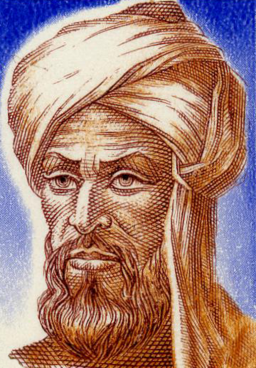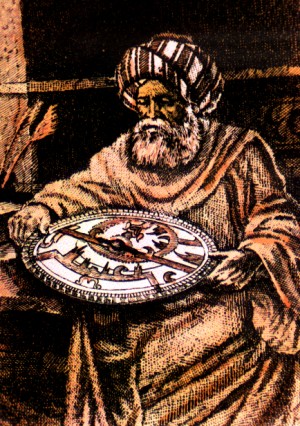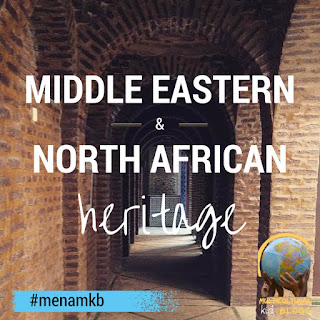This post is part of the Multicultural Kid Blogs' Middle Eastern and Northern African Heritage Month Blog Series and Giveaway. To enter the giveaway scroll to the bottom. I thought I would continue my look at multicultural mathematics by looking at some of the Middle Eastern mathematicians and mathematics from the Middle East. Unfortunately I was not able to find books that shared this information that Hazel could understand. I am sharing a bit about a few mathematicians and lessons to go with their discoveries as well as a bit on Islamic art and lessons as well.
Abū ‘Abdallāh Muḥammad ibn Mūsā al-Khwārizmī
The first and probably most famous mathematician from this area is Abū ‘Abdallāh Muḥammad ibn Mūsā al-Khwārizmī. His story is really a continuation of our History of Zero. Al-Khwarizmi was from Persia (today's Iran). He lived in the end of the 9th and beginning of the 10th centuries.
 |
| al-Khwarizmi By ms [Public domain], via Wikimedia Commons |
Latin translations from the 12th century of his work on arithmetic brought many of the Hindu ideas of place values and numerals to the Western world. The term algorism is the technique to performing arithmetic with the Hindu-Arabic numerals that al-Khwarizimi used. The word algorithm is derived from algorism. The spreading of his work had a profound impact on mathematics in Europe.
His major accomplishment in the mathematics world however was the the birth of algebra. The word itself comes from the term he used, al-jabr, to describe performing the same operation on both sides of the equation. His book included every way of solving a polynomial equation up to the second degree (or with the highest term squared). Our notation of x2 had not been invented yet so he had to describe such things in term like a thing multiplied by itself. His astronomy book also included the sine and cosine tables showing his knowledge in trigonometry.(Source)
 He discovered that tangent of an angle is equal to the sine of the angle divided by the cosine of the angle, or
He discovered that tangent of an angle is equal to the sine of the angle divided by the cosine of the angle, or
He also made a few other discoveries in trigonometry. (Source)
The perfect lesson to go with al-Battani is proving trigonometric identities (especially since his discoveries are often used in them). Purple Math has some great examples of how to prove them and Tutor Vista has a worksheet.
He made many contributions to geometric algebra as well as to geometry.He worked on Non-Euclidean geometry and disproving some of the past work. (Source)
A fun lesson to go with Khayyam is exploring conic sections. He insisted they were needed to solve cubic equations. I shared my note sheet for students and answers as well as other resources to go with conic sections in my post about Hypatia.
I cannot discuss the math of this region without mentioning the beautiful geometric art that decorates many buildings in the region. Many Muslims fear that having figures in artwork is idolatry, so the art was focused on patterns instead.
Through this art there were mathematical discoveries including all forms of symmetry can be depicted on a two-dimensional surface. (Source) Many of their artworks are also tessellations and this was always a fun way to bring multicultural lessons to geometry.
The Met Museum has a great downloadable resource activity packet on Islamic Art and Geometry and the Victoria and Albert Museum also provides some lessons to go with their Islamic art on display.
To go the route of tessellations, check out the Tessellation Creator on the National Council of Teachers of Mathematics Illumination site. Math Forum has an activity to investigate tessellations with pattern blocks. Here are many activities to investigate symmetry and tessellations. Math Salamanders provides several worksheets and information sheets on tessellations.
There are many other famous mathematicians from the Middle East, but I am going to stop at this point today in our lesson. Now for the giveaway!
His major accomplishment in the mathematics world however was the the birth of algebra. The word itself comes from the term he used, al-jabr, to describe performing the same operation on both sides of the equation. His book included every way of solving a polynomial equation up to the second degree (or with the highest term squared). Our notation of x2 had not been invented yet so he had to describe such things in term like a thing multiplied by itself. His astronomy book also included the sine and cosine tables showing his knowledge in trigonometry.(Source)
A lesson to go with this piece of history is solving equations. Here is a fun looking activity on Learn NC: Chutes and Ladders - Quadratic equations review. Here is a fun looking Multi-Step Equations Relay Race over at Teachers Pay Teachers (it is free).
Abū ʿAbd Allāh Muḥammad ibn Jābir ibn Sinān al-Raqqī al-Ḥarrānī al-Ṣābiʾ al-Battānī
Abū ʿAbd Allāh Muḥammad ibn Jābir ibn Sinān al-Raqqī al-Ḥarrānī al-Ṣābiʾ al-Battānī was born in 858 in Harran which is in present day Turkey. Not much is known about his life and he is most famous for his work in astronomy. However he did contribute to trigonometry. |
| al-Battani See page for author [Public domain], via Wikimedia Commons |
 He discovered that tangent of an angle is equal to the sine of the angle divided by the cosine of the angle, or
He discovered that tangent of an angle is equal to the sine of the angle divided by the cosine of the angle, orHe also made a few other discoveries in trigonometry. (Source)
The perfect lesson to go with al-Battani is proving trigonometric identities (especially since his discoveries are often used in them). Purple Math has some great examples of how to prove them and Tutor Vista has a worksheet.
Omar Khayyám
Omar Khayyám was a medieval Persian mathematician and scientist. Some say he was the most influential scientist of all time. In 1070 he wrote Treatise on Demonstration of Problems of Algebra which included a solution to solving a cubic equation by intersecting a hyperbola and a circle. |
| Khayyam By The original uploader was Atilin at French Wikipedia [GFDL or CC-BY-SA-3.0], via Wikimedia Commons |
He made many contributions to geometric algebra as well as to geometry.He worked on Non-Euclidean geometry and disproving some of the past work. (Source)
A fun lesson to go with Khayyam is exploring conic sections. He insisted they were needed to solve cubic equations. I shared my note sheet for students and answers as well as other resources to go with conic sections in my post about Hypatia.
Islamic Art
I cannot discuss the math of this region without mentioning the beautiful geometric art that decorates many buildings in the region. Many Muslims fear that having figures in artwork is idolatry, so the art was focused on patterns instead.
 |
| Samarkand, Shah-i Zinda By Patrickringgenberg (Own work) [GFDL or CC BY-SA 3.0], via Wikimedia Commons |
Through this art there were mathematical discoveries including all forms of symmetry can be depicted on a two-dimensional surface. (Source) Many of their artworks are also tessellations and this was always a fun way to bring multicultural lessons to geometry.
 |
| Imam Mosque Entrance in Isfahan, Iran By Fulvio (http://www.flickr.com/photos/lfphotos/1267872698/) [CC BY 2.0], via Wikimedia Commons |
To go the route of tessellations, check out the Tessellation Creator on the National Council of Teachers of Mathematics Illumination site. Math Forum has an activity to investigate tessellations with pattern blocks. Here are many activities to investigate symmetry and tessellations. Math Salamanders provides several worksheets and information sheets on tessellations.
There are many other famous mathematicians from the Middle East, but I am going to stop at this point today in our lesson. Now for the giveaway!



